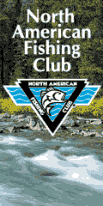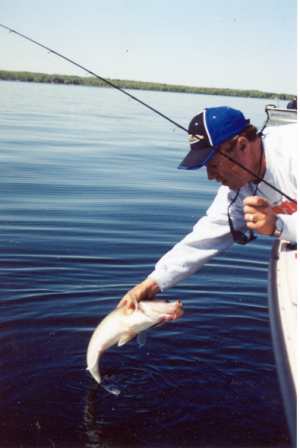
Free 90 day Risk free trial offer click
here






















|
Float Hopes
By Norb Wallock
The thought of bobber fishing for walleyes doesn’t instill a sense of
excitement in a lot of anglers, and seems simple to the point of being
crude. The fact is, nothing could be further from the truth, and when done
right it, is a form of art. It’s a lot more than simply clipping on a bobber
and waiting for something to
happen; A whole lot more. Successful float fisherman have found that
this tried and true method can get a bait into areas that theretofore have
been nearly impossible to fish. By putting the right bait in the right
place, and keeping it
there, you can maximize your chances for boating ol’ marble eyes. A
float (a.k.a. bobber), can do exactly that, but to get the job done certain
factors have to be taken into consideration. The key is knowing where,
when, and on what, to bet all of your hopes on a float.

Thill
Center slider float
One
of many types
of
slip floats available |
The “where” is ninety percent of the equation, and will determine if
a float is the best application for the given situation. Areas that would
get the thumbs up are shallow rocky reefs and bars, ( the obvious), as
well
as dee1per points and humps, and even specific areas along weed edges. |
Specific areas include deep weedy points, inside turns, and open pockets
in the middle of a weed flat. All of the aforementioned areas can help
to concentrate fish, and is a situation custom made for a float and live
bait presentation. Anytime walleyes bunch up in specific, easily identified
areas, floats have a chance to produce. Flats, gradual breaks, and anywhere
you find fish that are spread out, gets the thumbs down. For floats to
be effective, you better have a concentration to work, as the method is
simply too slow to cover a lot of water. Situations like these call for
quicker methods, like rigging, or even trolling, which can allow you to
move much quicker, and get your bait in front of a much larger audience.
Bringing a float to a trolling or rigging bite is like bringing a knife
to gun fight; You’re going to come up a little short.At the center of the
presentation is the float itself, and there has never before been so many
options. The latest entries are the European style floats, which have earned
a spot in the walleye angling lineup.
Although the sleek European floats can be effective, they are definitely
not for every situation.
Where they have proven themselves is under tough conditions, and dead
calm water. The sleek, slender
style, offers little resistance to a fish that has taken the bait,
and will keep him holding on longer, giving you more time to set the hook.
Too much resistance and a light biting walleye can easily reject the bait,
leaving you empty handed.
Where they don’t do well is under the onslaught of heavy waves, which
just so happens to be when
shallow water walleyes are most active. |
 Norb Wallocdk the author brings
Norb Wallocdk the author brings
in a Float Walleye
|
The problem with the slender profile float is their lack of buoyancy, which
allows the float to slide into, and under, the first good wave, never to
be seen again until reeled back in. A situation like that calls for a good
old fashioned Styrofoam slip bobber, which has the ability to stay on top
of the heaviest seas, and can help to keep your bait in front of the fish,
where it belongs. To keep the resistance problem to a minimum, add as much
split shot as you can, while still retaining the ability to stay on top.
The whole idea behind a float is to suspend a bait, like a leech, minnow,
or night crawler, and there are several options. The first option would
be the use of a plain hook, which is used most often. Good hook selections
would match the size of the hook to the bait being used. Leeches call for
hooks in sizes six to eight, like the VMC Octopus Needle Point series.
Crawlers are better suited to hooks in sizes four to six, while minnows
may range from six to even a 1/0, depending on the size of the minnow.
Another option is to replace the plain hook with a small jig head. Jig
heads do a couple of things, including giving the bait some color, as well
keeping a swimming bait pinned in place. Leeches and minnows tend to swim
up, and out of the walleye zone, and who would blame them. Jig heads in
the
1/32 to 1/4 ounce range are the ticket, with size determined by the
type of bait your using, and the existing conditions. Heavier waves and
larger baits call for larger jigs. The key is to use just enough weight
to get the job done.
Hooking options include running the hook through a leeches sucker,
which is the tail end (contrary to popular belief), and will allow it to
keep swimming and attracting ’eyes on the prowl. Crawlers can be hooked
through the middle, which will help to nail the short strikers. Another
method uses a half of a crawler, that is threaded onto a jig head. If you’re
using crawlers and missing fish, try the half crawler option. One of the
toughest part of successful float fishing is setting the hook, after a
fish has taken the bait. One of the keys is getting all of the slack out
of the line, before the set. To help with the slack factor, longer spinning
outfits in the eight to nine foot range are in order. Longer rods with
light tips allow you to pick up more line on the set, which will result
with fewer misses. Another key is waiting until you feel some of the
weight of the fish in the rod tip, before giving it the old heave ho.
If you set too soon, chances are the fish will feel the commotion and spit
out the bait. Float fishing has gone high tech, and is a weapon that deserves
a spot in any serious walleye anglers arsenal. The next time you run into
walleyes in a bad neighborhood, or with a bad attitude, try giving a float
a try, as you just might surprise yourself.
Norb Wallock

Walleyes Inc. website is maintained
by Randy
Tyler Fishing the In-Fisherman Professional Walleye Circuit, Masters
Walleye Circuit and the Team Walleye Circuit. All rights reserved.Copyright
1999/2001
Please visit these site sponsors
Daiichi/Tru-Turn Hooks,
Lindy
Little Joe,
R-A.M Mounting Systems,
Ranger
boats,
Mercury Marine, Bedford
Sales , Hamby's Beaching Bumpers,
Goldeneye
Marine products, Panther
Marine Products, Webfoots body
sock, Bait Rigs Tackle
|




